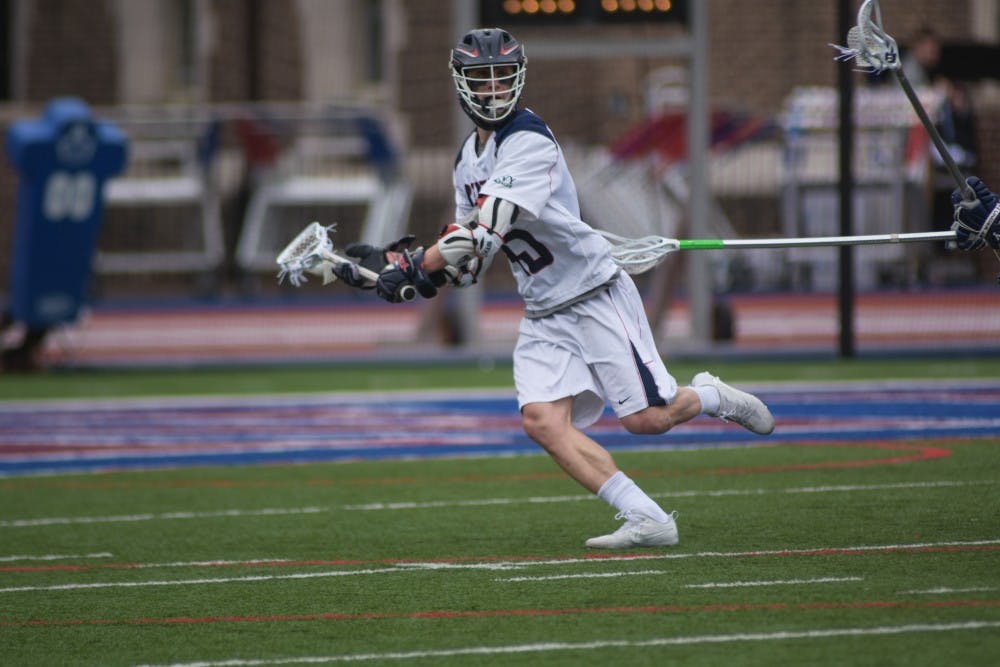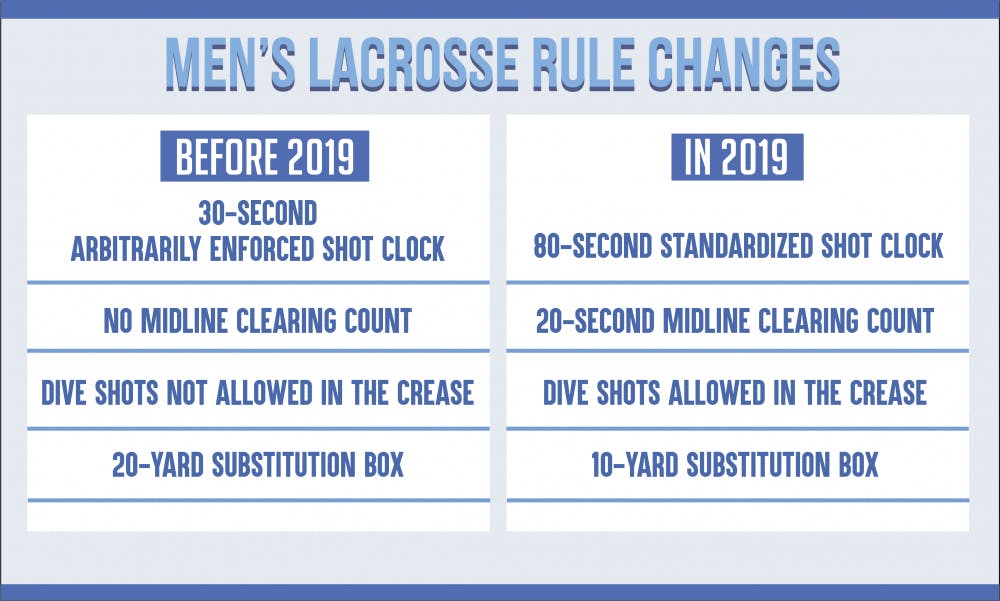
Senior Simon Mathias, who is has scored the ninth most goals in program history, is excited for the "Shot Clock Era."
Credit: Pranay VemulamadaIt’s a brand new season for Penn men’s lacrosse, and the adjustments for the Quakers this year will extend beyond the coaching staff changes, the incoming freshmen and transfers, and the team's difficult schedule.
2019 will be a historic season for the entire sport, as it marks the beginning of the much-hyped "Shot Clock Era."
Every two years, college lacrosse coaches from across the country meet to evaluate the sport's progression. This past summer, coach Mike Murphy found himself right in the thick of the discussion. He was part of the eight-member NCAA Men’s Lacrosse Committee that was assigned this crucial task.
Murphy and his fellow coaches decided that changes needed to be made, especially pertaining to the shot clock, which had been recently implemented but shrouded in subjectivity.
Before the rule change, referees had to institute a 30-second shot clock whenever they felt the offense was stalling or holding onto the ball too long. This scenario created difficulties, not the least of which was a lack of consistency from the officials. Without a clear standard of what constituted “attacking the goal” or “running out the clock,” the referees were given an impossible task.
After a slight tinkering of the Committee’s proposal from the NCAA Playing Rules Oversight Panel and the approval from a national coaches’ survey, that subjectivity will be removed from the game.
Now, for the first time in college men's lacrosse history, a standardized shot clock will be employed. The 80-second countdown will start immediately after a team establishes possession of the ball, and only 20 of those 80 seconds can be spent on the team’s defensive side of the field.
The new shot clock will encourage teams to carry the ball into the attacking zone as quickly as possible. In this way, not only will the subjectivity of a referee-imposed shot clock be replaced, but also, pace of play should see a marked improvement over years past.

“The intended design of the rule wasn’t necessarily to increase the pace but rather to be more consistent with timers and things like that,” Murphy said. “But I think it will increase the pace a little bit. It’s a little early to tell, but now that some games have been played, you can see that some teams are speeding up.”
The hope for Murphy and the Quakers is that the increased pace benefits them directly.
“We’ll play guys that can get up and down,” Murphy said. “And I think it will help us certainly as we try to attack from defense to offense.”
Members of that offense, like senior attackman Simon Mathias, share Murphy’s enthusiasm.
“It’s been rumored for a while that they were going to try out a shot clock, so I’m just glad that as a senior I’ll be able to give it a try,” Mathias said. “It’s something that I’ve hoped was going to happen.”
Although the new shot clock has grabbed most of the headlines this past offseason, it is not the only rule change that will be added for the 2019 season.
Keeping with the theme of increased pace, the Committee shortened the substitution box from 20 yards to 10 yards, making it more difficult for on-the-fly substitutions and potentially allowing for additional transition opportunities.
“The new box is going to be very interesting,” Murphy said. “That, combined with the [shot] clock, will make it very difficult for teams to just run off the field. It’ll be harder to get guys off and on.”
These substitution difficulties should increase the importance of transition players like highly touted freshman long stick midfielder BJ Farrare who could be leaned on to serve as an offensive catalyst in the attacking zone.
“In high school, I tried to create as much transition as possible, and I’m going to try to do the same here,” Farrare said. “For clearing, it’ll be a bit tougher. Guys will have to run further, so things will take more time to develop, but Coach has told [goalie Reed Junkin] to look up right off a save and to try to hit [defensive midfielders] right away before teams can set up their rides."
The last — but arguably most intriguing — rule change for this upcoming season is the reinstitution of the dive. Once again, offensive players will be allowed to leave their feet and land in the crease on a shot attempt as long as they propel themselves across the face of the goal and away from the goalmouth. With this added move in their arsenals, attackmen who do damage around the goal will become even more dangerous — and more exciting.
“The dive will also be very interesting,” Murphy said. “It totally changes the way teams are going to play defensively. You combine the dive with the shot clock, and you’ll have a lot more urgent situations than you’ve had previously, and when you’re in those end-of-clock situations, why wouldn’t you just try for the dive?”
As for how these new changes will impact Penn specifically, Murphy seemed optimistic.
“I think that we have a couple of guys that are pretty good at diving. Simon [Mathias] won us the Bucknell game last year in a desperate situation when we were tied with nine seconds left. If we have those types of situations once a quarter or twice a quarter, I think that it’ll come into play more, and with guys like Simon and [senior midfielder] Tyler [Dunn], I think that we’ll be pretty good at it.”
All told, Penn men’s lacrosse appears ready to face the 2019 season, rule changes and all.
The Daily Pennsylvanian is an independent, student-run newspaper. Please consider making a donation to support the coverage that shapes the University. Your generosity ensures a future of strong journalism at Penn.
Donate







